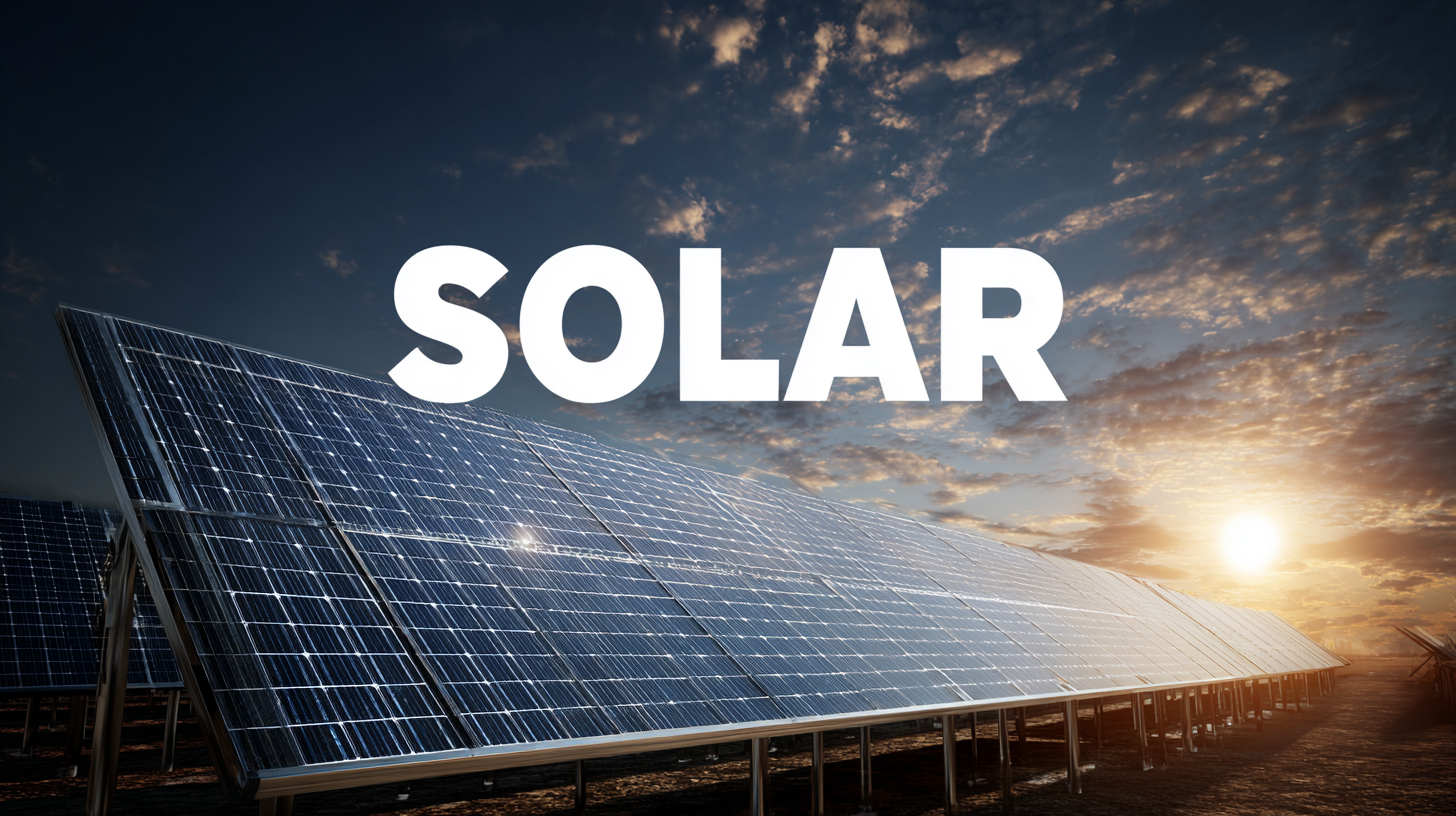
Essential Checklist for Choosing the Best Solar Panel for Your Home in 2023
In 2023, the demand for renewable energy solutions, particularly solar panels, has surged significantly as homeowners seek sustainable ways to reduce their carbon footprint and energy costs. According to a recent report by the International Energy Agency (IEA), global solar photovoltaic (PV) capacity is expected to reach 1,000 gigawatts by the end of the year, with residential installations playing a pivotal role in this growth. This trend underscores the importance of selecting the right solar panel for your home, as not all products meet the same efficiency and durability standards. With innovations in technology driving advancements in solar panel performance, consumers are faced with a myriad of options, necessitating a comprehensive checklist to guide their purchasing decisions. As Chinese manufacturers become increasingly prominent on the global stage, emphasizing quality and reliability, it is crucial for homeowners to understand the key factors that influence their choice of solar panels to ensure optimal functionality and long-term savings.

How to Identify Quality Solar Panel Manufacturers in 2023
When selecting the best solar panels for your home, identifying quality manufacturers is crucial in ensuring you make a wise investment. Start by researching various brands and their reputation in the solar industry. Look for companies with a proven track record, established longevity in the market, and positive customer reviews. Manufacturers that have been in business for over a decade often have the experience to provide reliable products. Additionally, consider their financial stability; a strong financial background indicates that they are likely to be in business long-term, which is essential for warranty support.
Another important factor is the certifications and warranties offered by the manufacturers. Look for products that meet industry standards and certifications, such as those from the International Electrotechnical Commission (IEC) or Underwriters Laboratories (UL). A reputable manufacturer should offer comprehensive warranties, including at least 25 years for performance and defects. Understanding these certifications not only helps ensure quality but also instills confidence in the long-term performance of the solar panels you choose. By paying attention to these details, you can narrow your options to the best quality solar panel manufacturers in 2023.
Essential Checklist for Choosing the Best Solar Panel for Your Home in 2023
| Criteria | Details |
|---|---|
| Efficiency Rating | Choose panels with 15% to 22% efficiency for optimal power generation. |
| Warranty Period | Look for at least 25 years warranty on performance and product. |
| Temperature Coefficient | Select panels with a lower temperature coefficient for better performance in heat. |
| Certification Standards | Ensure compliance with IEC 61215 and IEC 61730 standards for safety and durability. |
| Cost per Watt | Compare average cost per watt ($/W) to find economical options without compromising quality. |
| Vendor Reputation | Research manufacturer reviews and longevity in the market. |
| Installation Options | Consider availability of professional installation services or DIY kits. |
| Customer Support | Evaluate the responsiveness and support from the manufacturer post-purchase. |
Key Features to Consider When Selecting Solar Panels for Your Home
When selecting solar panels for your home in 2023, it's crucial to consider several key features that can significantly impact efficiency and overall performance. One of the most important metrics is the solar panel efficiency rating, which typically ranges from 15% to 22% for residential panels. According to the National Renewable Energy Laboratory, a higher efficiency rating means that a panel can convert more sunlight into electricity, helping homeowners to generate more energy with less roof space. This is especially beneficial for homes with limited roof area, as it allows for maximum energy production within confined limits.
Another essential factor is the panel's durability and warranty. The best solar panels come with a warranty period ranging from 25 to 30 years, indicating their expected lifespan and reliability. Research from Solar Power International suggests that panels with a longer warranty typically have lower degradation rates, often around 0.5% to 0.8% per year, compared to lower quality options that may degrade at rates of 1% or more. Homeowners should also consider the type of solar panels, such as monocrystalline or polycrystalline, as they have different performance characteristics and costs, influencing both upfront investment and long-term savings on energy bills.

Understanding Different Types of Solar Panels and Their Benefits
When choosing the best solar panel for your home in 2023, understanding the different types available is crucial. There are primarily three types of solar panels: monocrystalline, polycrystalline, and thin-film, each offering distinct benefits. Monocrystalline panels are known for their high efficiency and sleek appearance, making them a popular choice for homeowners looking to maximize energy output in limited roof space. Their longevity and performance, especially in low-light conditions, also make them a worthwhile investment.
On the other hand, polycrystalline panels are often more affordable and easier to manufacture, which can make them an appealing choice for budget-conscious consumers. While slightly less efficient than their monocrystalline counterparts, they still deliver solid performance in sunny conditions. Lastly, thin-film solar panels are the lightest and most flexible option, allowing for a variety of installations, including unconventional spaces. Though they typically have lower efficiency rates, their affordability and suitability for large-scale applications can be beneficial. Each type serves different needs and preferences, so it's essential to evaluate which panel aligns best with your energy goals and home specifications.
Essential Checklist for Choosing the Best Solar Panel for Your Home in 2023
This chart illustrates the efficiency levels of the three common types of solar panels available in 2023: Monocrystalline, Polycrystalline, and Thin-Film. This information is crucial when selecting the best solar panel for your home's energy needs.
Evaluating Warranty and Support Options for Solar Panel Purchases
When investing in solar panels, evaluating warranty and support options is crucial to ensure long-term satisfaction and reliability. According to a report by the National Renewable Energy Laboratory (NREL), most reputable solar manufacturers offer warranties that typically cover 25 years for performance and 10-12 years for product defects. This level of assurance can provide homeowners peace of mind, as solar panels are a long-term investment.
 Moreover, it's important to understand what the warranty entails. A strong warranty should cover not only equipment and performance but also installation defects. The Solar Energy Industries Association (SEIA) notes that choosing a company with robust warranty options can significantly enhance your solar investment’s value, especially since average system lifespans can exceed 30 years. Additionally, support options such as customer service responsiveness and accessibility of technical assistance can greatly affect your experience.
Homeowners should look for companies that offer ongoing monitoring and maintenance services to maximize energy efficiency and panel longevity.
Moreover, it's important to understand what the warranty entails. A strong warranty should cover not only equipment and performance but also installation defects. The Solar Energy Industries Association (SEIA) notes that choosing a company with robust warranty options can significantly enhance your solar investment’s value, especially since average system lifespans can exceed 30 years. Additionally, support options such as customer service responsiveness and accessibility of technical assistance can greatly affect your experience.
Homeowners should look for companies that offer ongoing monitoring and maintenance services to maximize energy efficiency and panel longevity.
By prioritizing these warranty and support aspects, you can select a solar panel system that not only meets your energy needs but also safeguards your investment in the unpredictable landscape of renewable energy.
Tips for Comparing Solar Panel Prices and Financial Incentives
When selecting solar panels for your home in 2023, understanding the financial incentives and pricing comparisons is crucial. According to the Solar Energy Industries Association (SEIA), the average cost of solar panels has decreased by over 70% since 2010, making solar energy more accessible than ever. In many regions, homeowners can expect to pay between $15,000 to $30,000 for a complete solar panel installation, depending largely on system size and energy needs. However, this upfront investment can often be mitigated by federal and state tax incentives, which can cover a significant portion of the cost.
It's essential to compare quotes from different solar providers while considering any available financial incentives. Beyond federal tax credits, many states offer local rebates and financing options that can further reduce costs. The Database of State Incentives for Renewables & Efficiency (DSIRE) lists over 2,000 incentive programs across the United States.
Additionally, homeowners should explore leasing options or power purchase agreements (PPAs), where the initial cost is lowered, and savings are realized over time through reduced electricity bills. Properly assessing your financial options can lead to a well-informed decision that maximizes your investment in solar energy.

